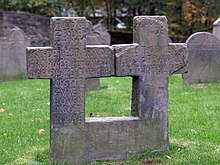St. Peter in Syburg
St. Peter zu Syburg is a church on the Syberg in the Syburg district of Dortmund .
history
The church is the oldest sacred building in Dortmund's urban area. A previous building of today's church was mentioned in a document as early as 776. At that time the Saxons attempted a reconquest of a year earlier by Charlemagne occupied Hohensyburg . The church was probably built in 799 by Pope Leo III. Visited on his way to or from Paderborn. It seems rather unlikely that he consecrated the church during this visit, since it had existed for more than two decades at the time.
The current church construction is dated to the middle of the 12th century. At that time it was built as a flat-roofed hall building with a defensive character , and the west tower was added in the 13th century. In the Middle Ages, the church was of great importance as a place of pilgrimage and indulgence church . In the 13./14. In the 19th century the church was expanded to include a Gothic choir . In 1673 the church was destroyed by fire during the French wars of prey .
During the Second World War , the church was badly damaged by an aerial bomb on the longship; from 1953 to 1954 it was restored. During excavations (1950/51, 1976/77 and 1983) foundations of a Romanesque apse and a Carolingian rectangular building were discovered.
After the reconstruction, the church was equipped with glass windows by Walter Benner . The altar cross, the Lord's Supper, lectern and Easter candlestick come from Egino Weinert's workshop .
The church is surrounded by an associated cemetery. Gravestones from the 9th century can be found on what is probably the oldest court of the dead in the Ruhr area. A Merovingian tombstone and two Carolingian tombstones are kept in the church, as is a Romanesque baptismal font , which originally comes from Lütgendortmund and was acquired from the Dortmund Museum for Art and Cultural History after the war.
The church is registered as an architectural monument in the list of monuments of the city of Dortmund .
organ
In 1998 the church received a new organ from the workshop of Claus Sebastian (Geesthacht). The purely mechanical instrument has 20 registers (including three transmission registers) on two manuals and a pedal . The first manual serves as a coupling manual.
|
|
|
|||||||||||||||||||||||||||||||||||||||||||||||||||||||||||||||||||||||
Bells
Three bronze bells are hung directly under the roof. The smallest bell is a loan bell from Pomerania. It was cast in 1681 and can be heard in b ′. The middle bell was made in 1584 and sounds in a ′. The big bell was originally cast in 1850 and destroyed in World War II. In 1961 the Rincker foundry in Sinn cast a new bell in g ′.
In the literature
Gertrud von le Fort set her story Spökenkieken in the church of Syburg and its surroundings. As a young girl, von le Fort had visited her godmother at Haus Villigst (Schwerte) and from there also undertook trips to Syburg. A tombstone in the Church of St. Peter in Syburg inspired her to write the story, which first appeared in Westermann's monthly magazine in 1907. The story is now tangible again (see literature).
literature
- Rüdiger Jordan: Of capitals, pulpits and baptismal fonts. An exciting guide to 67 churches and monasteries in the Ruhr Valley. Klartext Verlag, 2006, ISBN 3-89861-436-0 .
- Renate Breimann: Ev. Church of St. Peter in Syburg, church leader. Ingrid Lessing Verlag, 2007, ISBN 978-3-929931-24-2 .
- Gertrud von le Fort: Spökenkieken. A love story about the church of St. Peter zu Syburg and Haus Villigst. Commented and illustrated by Renate Breimann. Ingrid Lessing Verlag, 2010, ISBN 978-3-929931-28-0 .
Web links
- http://www.ev-kirche-syburg-hoechsten.de
- http://www.ev-kirche-dortmund.de/kirche-und-stadt/fundraising/stiftung-denkmalswerte-kirchen/kirchen/kirchen-in-dortmund/31-st-peter-zu-syburg
- http://www.syburg.de/sy-kirche-st-peter.htm
Individual evidence
- ↑ No. A 0409. List of monuments of the city of Dortmund. (PDF) In: dortmund.de - The Dortmund city portal. Monument Authority of the City of Dortmund, April 6, 2018, accessed on November 14, 2018 (size: 814 kB).
- ↑ To the organ
Coordinates: 51 ° 25 ′ 20 ″ N , 7 ° 29 ′ 21 ″ E





